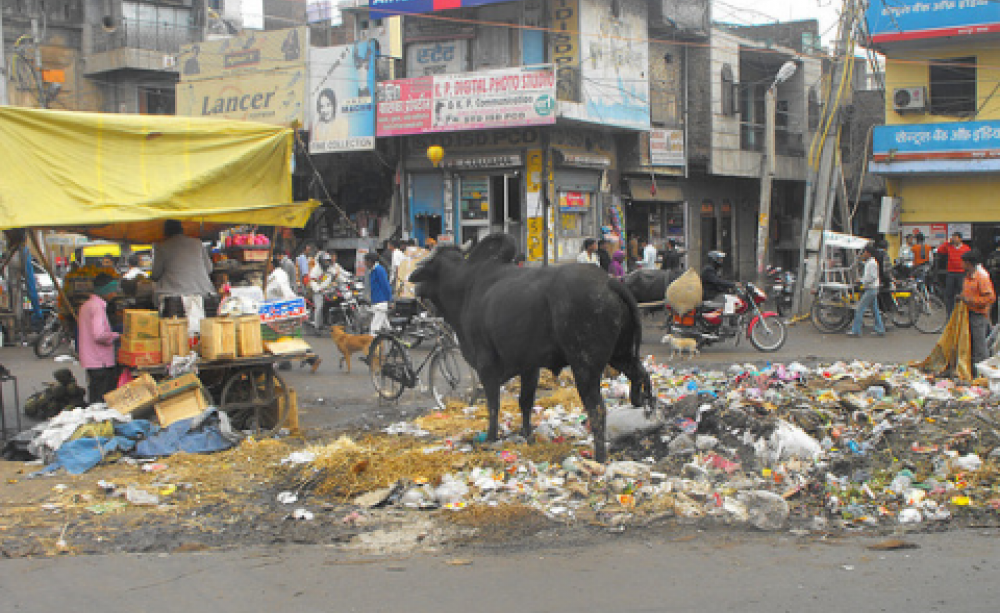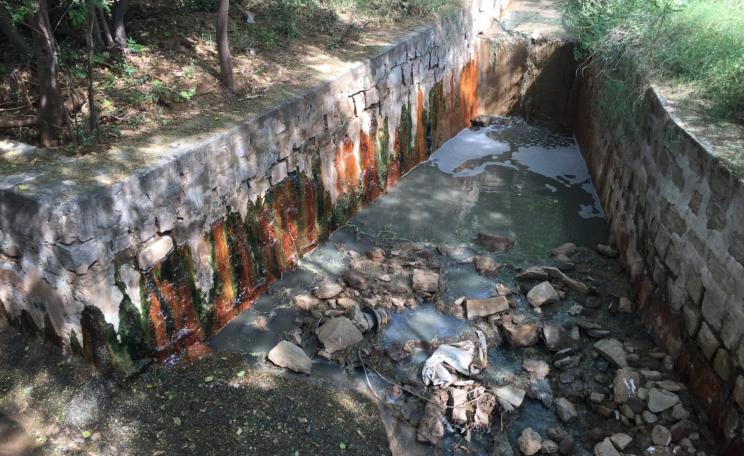About 70 per cent of water effluents are not treated and disposed off into the environmental media untreated.
As the train approached the city of Mumbai I could smell the river of putrid sludge flowing through the slums which border the train tracks. Mountains of rubbish from daily waste accumulated behind every household whilst children played on top of them barefoot.
I finished my lunch and searched for a bin to throw the water bottles and food packaging left over from a 21 hour train journey. The Indian family sitting opposite me were observing my moves with astonished eyes. Since I could not find one, I looked at them and tried to ask for a plastic bag.
To my surprise, the mother collected all my rubbish and, without hesitation, she threw it out of the window.
Absence of proper sanitation
Most trains in India lack sanitation facilities such as rubbish bins and it is commonly accepted that all garbage is disposed outside, onto the rails. One of the young workers who serves food in the train asked:
"That is just how it is done. If we throw it outside someone will eventually pick it up or burn the rubbish. I have seen people do it. What do we do with it if not?"
Indian railways consist of 64,000 route km which handles 20 million passengers a day, which is almost 2% of the Indian population, according to a 2012 Indian government panel report.
Some journeys may take one or several days non-stop, in which every passenger generates waste from at least three meals and one plastic bottle daily.
Train toilets are also a matter of great concern. In these open toilets human waste falls directly onto the tracks deteriorating them. As the Report points out:
"Apart from the issue of hygiene, this has several serious safety implications arising out of corrosion of rails and related hardware."
In the year 2000 the Indian government set up plans to change train toilets and improve sanitation, as well as put in place various laws in relation to the development of solid waste management systems, landfills, recollection and other solid waste management measures.
But the results of these laws and regulations are not easily perceived. An example of this is the ban on plastic bags which was introduced in India in 2011.
In Delhi the violation of the ban is punishable with up to five years of imprisonment or with a fine of up to 100,000 rupees (1,200 Euros). Despite this, plastic bags are seen everywhere.
"We have to continue doing business and with no other alternative in place, distributing plastic bags to our clients is and will continue to be part of it", says the owner of a clothes shop in Delhi. "Either way, who will come and check?"

Kolkata street with pile of rubbish. Photo: Ben Sutherland / Creative Commons 2.0.
Modern India
India is the second most populated country in the world after China, according to United Nation's reports, 17.4% of the world's population lives there. It is also close to becoming one of the world powers as part of the 'emerging four' or BRIC countries (Brazil, Russia, India and China).
About 70 per cent of water effluents are not treated and disposed off into the environmental media untreated.
But as modernity clings its jaws over it's territory, with advances in industry and technology, implementing effective waste management systems seems an Herculean task.
High income countries generate far more waste than those with low income. In 1999 India genenerated 0.46 kg of waste a day, whereas Hong Kong generated 5.07 kg, according to a World Bank report.
Other studies indicate that on average, for every 1000 rupees increase in income, solid waste generation increases by one kg per month.
The type of waste is also different, becoming more toxic and non-biodegradable as industrialisation grows, with electronic waste and plastic being the main problems. A small scale example of how India is not following up to it's economic growth can be seem if we compare urban India and deep rural India.
No-waste Land
Lost between mountains and valleys at the foothills of the Himalayas there is hardly no evidence of human activity but for small houses and farmlands which merge with the bright greenery.
Bhuppi's family farm is situated here, in the Northern state of Uttarakhand. Almost all their waste is biodegradable and the left overs are used as compost for their fast-growing fields or as food for their cattle.
Whatever other waste is left, such as plastic packaging, is carefully separated and put into a rubbish bag which is then taken up the mountain to the nearest village for collection.
Bhuppi says that he feels "bad" walking the streets of bigger cities near his home because of all the garbage spreading everywhere "it seems that more and more Indian people seem to not understand the consequences of this".
Indian not-for-profit organization 'Vatavaran' deals with issues of solid waste management both in big cities such as Delhi and in small communities in villages around India.
Vatavaran explains that when working with villagers, what is surprising is "their self-sufficiency and awareness in managing waste and pollutants in comparison to people living in big cities and villages in India"
After spending some time in Bhuppi's remote farm I wondered about the fact that there were no hospitals or doctors in his village. The nearest hospital is in the city of Haldwani, 200 km away. To this Bhuppi answered: "nobody here gets really sick."
The absence of pollutants, safe water for drinking, bathing and irrigation along with the non-existence of garbage rotting nearby is keeping him and his family healthy.

Polluted river in India. Photo: Ajay Tallam / Creative Commons 2.0.
Rivers of filth
Whilst piles of garbage accumulate above the ground, the scope of this pollution extends its roots down and across, reaching underground water and contaminating rivers, and with little and ineffective treatment plants, it becomes fatal, resulting in high rates of water-borne disease.
According to a report by professor M. N. Murty and Surender Kumar, authors of a book discussing environmental accounting in India, "about 70 per cent of water effluents are not treated and disposed off into the environmental media untreated."
An example is the river Ganges, the National River of India, which traverses over 2,500 km and is one of most polluted river of the World.
The Ganges is worshipped by Hindus which consider it to be sacred. Yet - toxic industrial discharges aside - people all along its banks chuck their rubbish, wash their clothes and utensils in it; defecate, bathe, and celebrate funerals around its banks; and throw their dead into its waters to be granted instant spiritual salvation.
A recent study conducted by the National Cancer Registry Programme (NCRP) under the Indian Council of Medical Research, showed that the levels of cancer of people living around the Ganges basin was the highest in the country, due to poisonous metals and toxic chemicals which float in it.
The World Bank has initiated a $1.556 billion National Ganga River Basin Project, but throwing money at the problem is clearly not the solution. The World Bank admits in it's website:
"One of the reasons why earlier efforts to clean the Ganga did not take root was the lack of public participation. The various stakeholders, including the communities living along the river, the pilgrims, and the industries located in the river catchment did not fully appreciate the need for changing everyday practices that were polluting the river."
Solutions
Different organisations and NGOs are taking steps towards making India cleaner, such as NGO Let's do it World (LDIW), which organises massive clean ups of different cities across the world to engage the population and raise awareness. And as LDIW's Meelika Hirmo says:
"To create a resistant change in behaviour patterns, enough people must take part. Only when certain mass of people take part of the action in a short time, it creates an effect. Otherwise it's not really being noticed and people might go back to their bad habits."
A day clean up was carried out in Delhi in 2010 with the help of 50,000 volunteers, another one involving 32,000 volunteers took place in Indian city of Mysore, in the Sourthen state of Karnataka, on March 2013.
Mysore is the second cleanest city in India in 2013, according to the National City Rating, a nationwide Union Urban Development Ministry exercise. But on that one day clean-up volunteers still managed to collect 191 lorries of garbage thrown on the streets and open spaces.
The results of these events were surprising and the objective of cleaning up visible waste was achieved. "We are very glad to witness such activism and see that India has a lot of potential - big problems offer big solutions", says Meelika.
But the problem does not end here. Different strategies have to be complemented to avoid a one-trick-pony approach, making the solutions sustainable and for ever lasting instead.
For instance, Indian organisation Vatavaran promotes self-sustenance by creating models for people to replicate and spread the word. According to them, "this could relate to something as big as working with a whole urban village or teaching you how to make a vermin-pit."
Trying to introduce centralised government models of waste management, like we have in Europe, seems to be ending up in disaster. India is overpopulated but many hands can make it happen.
So the best way to save India from becoming the world's stinking cesspit must be to follow a grassroots approach: raising awarenes; and empowering people and communities to deal with the problem - for the sake of their health and their future.







